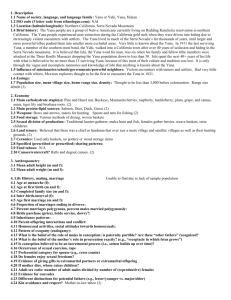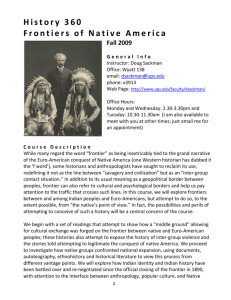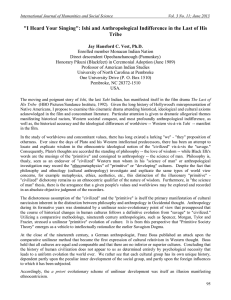print page close window Ishi was the last survivor of the Yana
advertisement
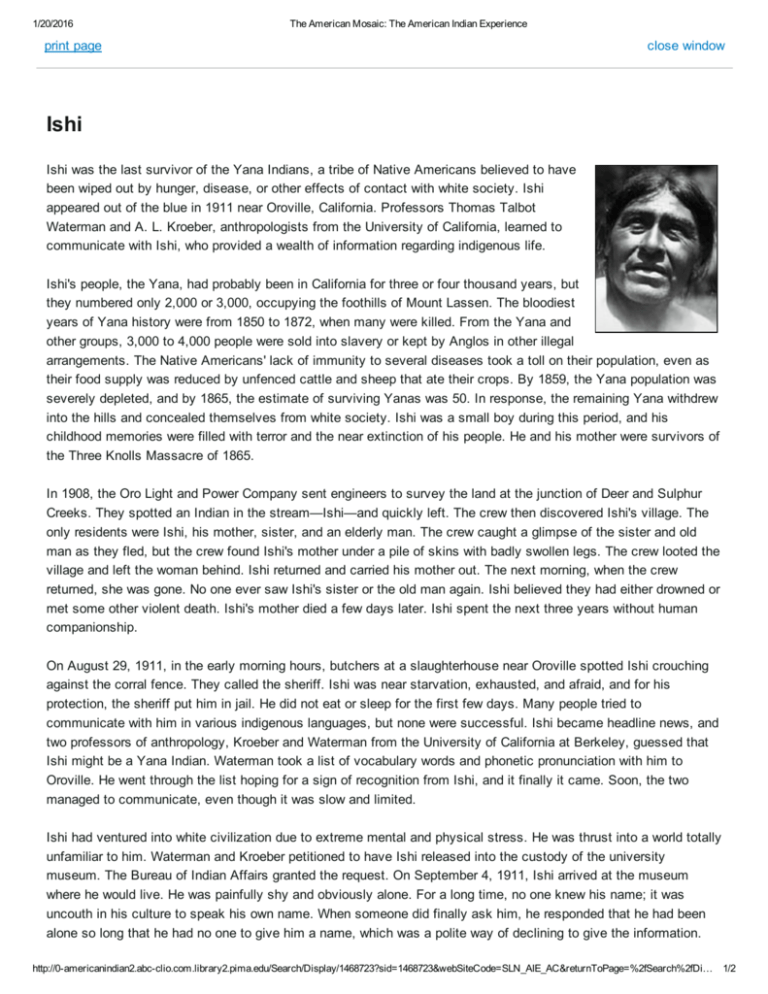
1/20/2016 The American Mosaic: The American Indian Experience print page close window Ishi Ishi was the last survivor of the Yana Indians, a tribe of Native Americans believed to have been wiped out by hunger, disease, or other effects of contact with white society. Ishi appeared out of the blue in 1911 near Oroville, California. Professors Thomas Talbot Waterman and A. L. Kroeber, anthropologists from the University of California, learned to communicate with Ishi, who provided a wealth of information regarding indigenous life. Ishi's people, the Yana, had probably been in California for three or four thousand years, but they numbered only 2,000 or 3,000, occupying the foothills of Mount Lassen. The bloodiest years of Yana history were from 1850 to 1872, when many were killed. From the Yana and other groups, 3,000 to 4,000 people were sold into slavery or kept by Anglos in other illegal arrangements. The Native Americans' lack of immunity to several diseases took a toll on their population, even as their food supply was reduced by unfenced cattle and sheep that ate their crops. By 1859, the Yana population was severely depleted, and by 1865, the estimate of surviving Yanas was 50. In response, the remaining Yana withdrew into the hills and concealed themselves from white society. Ishi was a small boy during this period, and his childhood memories were filled with terror and the near extinction of his people. He and his mother were survivors of the Three Knolls Massacre of 1865. In 1908, the Oro Light and Power Company sent engineers to survey the land at the junction of Deer and Sulphur Creeks. They spotted an Indian in the stream—Ishi—and quickly left. The crew then discovered Ishi's village. The only residents were Ishi, his mother, sister, and an elderly man. The crew caught a glimpse of the sister and old man as they fled, but the crew found Ishi's mother under a pile of skins with badly swollen legs. The crew looted the village and left the woman behind. Ishi returned and carried his mother out. The next morning, when the crew returned, she was gone. No one ever saw Ishi's sister or the old man again. Ishi believed they had either drowned or met some other violent death. Ishi's mother died a few days later. Ishi spent the next three years without human companionship. On August 29, 1911, in the early morning hours, butchers at a slaughterhouse near Oroville spotted Ishi crouching against the corral fence. They called the sheriff. Ishi was near starvation, exhausted, and afraid, and for his protection, the sheriff put him in jail. He did not eat or sleep for the first few days. Many people tried to communicate with him in various indigenous languages, but none were successful. Ishi became headline news, and two professors of anthropology, Kroeber and Waterman from the University of California at Berkeley, guessed that Ishi might be a Yana Indian. Waterman took a list of vocabulary words and phonetic pronunciation with him to Oroville. He went through the list hoping for a sign of recognition from Ishi, and it finally it came. Soon, the two managed to communicate, even though it was slow and limited. Ishi had ventured into white civilization due to extreme mental and physical stress. He was thrust into a world totally unfamiliar to him. Waterman and Kroeber petitioned to have Ishi released into the custody of the university museum. The Bureau of Indian Affairs granted the request. On September 4, 1911, Ishi arrived at the museum where he would live. He was painfully shy and obviously alone. For a long time, no one knew his name; it was uncouth in his culture to speak his own name. When someone did finally ask him, he responded that he had been alone so long that he had no one to give him a name, which was a polite way of declining to give the information. http://0­americanindian2.abc­clio.com.library2.pima.edu/Search/Display/1468723?sid=1468723&webSiteCode=SLN_AIE_AC&returnToPage=%2fSearch%2fDi… 1/2 1/20/2016 The American Mosaic: The American Indian Experience Under pressure from the press, Kroeber said his name was "Ishi." It was the Yana word for "man." He never revealed his own private name. Many people besieged the museum with requests to use Ishi's image in advertisements or to have him travel as an exhibit. The museum restricted access to him. Regularly on Sundays, Ishi demonstrated how to string a bow, build a fire, or chip an arrowhead, in exchange for which he received a small allowance for such treats as tobacco and ice cream. On his own, he began to work with the janitorial staff. The university paid him, and Kroeber taught him to sign his name and endorse his paychecks. In 1914, Ishi and the professors returned to the Deer Creek area to learn more about the Yana and their customs. The trip was a success, and plans were made for another, but in December 1914, Ishi developed a hacking cough and was hospitalized. Doctors suspected tuberculosis, but tests were negative. He recovered, only to be hospitalized again in the spring. The test for tuberculosis was positive this time, but by late spring, the doctors felt the disease had been arrested. In the summer, Ishi went to live with the Watermans. In August, it was apparent he was ill again and returned to the museum for care. Finally, he was hospitalized with acute symptoms of tuberculosis. Waterman saw that Ishi was unhappy in the hospital and took him home to die as was the custom of his people. On his deathbed, Ishi said, "You stay, I go." He died on March 25, 1916. Ishi was to have been cremated as was also customary, then have the ashes buried. Kroeber backed this plan and stipulated that no autopsy be performed, but he was away in Europe at the time of Ishi's death. Waterman, grief­ stricken and guilt­ridden for having worked Ishi so hard, tried to carry out these requests and succeeded to some extent. An autopsy was performed, and Ishi's brain was preserved. A death mask was taken. Ishi was cremated, his ashes placed in a black Pueblo jar in a coffin along with bows, arrows, shell bead money, and other goods. His remains were laid to rest at Mount Olive Cemetery. The inscription on the jar read "Ishi, the last Yana Indian, 1916." California Resource Link Further Reading Kroeber, Theodora, Ishi in Two Worlds: A biography of the Last Wild Indian in North America, 1961; Kroeber, Theodora, Ishi, Last of His Tribe, 1973. Select Citation Style: MLA MLA "Ishi." The American Mosaic: The American Indian Experience. ABC­CLIO, 2016. Web. 20 Jan. 2016. back to top Entry ID: 1468723 http://0­americanindian2.abc­clio.com.library2.pima.edu/Search/Display/1468723?sid=1468723&webSiteCode=SLN_AIE_AC&returnToPage=%2fSearch%2fDi… 2/2
![[Date] Dear [Manager`s Name], I would like to attend the 26th](http://s3.studylib.net/store/data/006774637_1-eb1b8004553e5d07ebd94c17b8b25e4e-300x300.png)

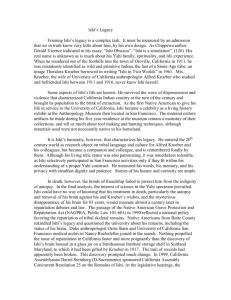
![Edward Sapir [1884-1939] - Frostburg State University](http://s2.studylib.net/store/data/005569801_1-deb1132f1ae8f0e8d561247b81673874-300x300.png)
